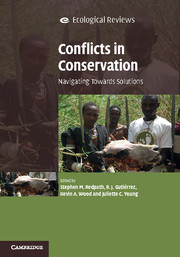Book contents
- Frontmatter
- Dedication
- Contents
- List of contributors
- Foreword by Georgina Mace
- Acknowledgements
- Part I Introduction to conservation and conflict
- PART II Contrasting disciplinary approaches to the study of conflict in conservation
- 3 The value of ecological information in conservation conflict
- 4 Environmental history and conservation conflicts
- 5 The political ecology of conservation conflicts
- 6 Understanding conservation conflicts: an economic perspective
- 7 Anthropological approaches to conservation conflicts
- 8 Law and conservation conflicts
- 9 The relevance of psychology to conservation conflicts
- 10 Conservation conflicts: ethical issues
- 11 A view from sociology: environmental movement mobilisation over old-growth temperate rainforests in British Columbia
- 12 Peace research and conservation conflicts
- 13 Linking conflict and global biodiversity conservation policies
- Part III Approaches to managing conflicts
- Index
- Plate Section
- References
8 - Law and conservation conflicts
from PART II - Contrasting disciplinary approaches to the study of conflict in conservation
Published online by Cambridge University Press: 05 May 2015
- Frontmatter
- Dedication
- Contents
- List of contributors
- Foreword by Georgina Mace
- Acknowledgements
- Part I Introduction to conservation and conflict
- PART II Contrasting disciplinary approaches to the study of conflict in conservation
- 3 The value of ecological information in conservation conflict
- 4 Environmental history and conservation conflicts
- 5 The political ecology of conservation conflicts
- 6 Understanding conservation conflicts: an economic perspective
- 7 Anthropological approaches to conservation conflicts
- 8 Law and conservation conflicts
- 9 The relevance of psychology to conservation conflicts
- 10 Conservation conflicts: ethical issues
- 11 A view from sociology: environmental movement mobilisation over old-growth temperate rainforests in British Columbia
- 12 Peace research and conservation conflicts
- 13 Linking conflict and global biodiversity conservation policies
- Part III Approaches to managing conflicts
- Index
- Plate Section
- References
Summary
Conflict is a dominant notion within the legal discipline. In this chapter, I review some roles that law and legal research play with respect to conservation conflicts. I first introduce briefly law and legal research and then discuss the respective roles of law and legal research with regard to conservation conflicts. Although I focus my discussion on Europe, many if not most of the general principles are applicable elsewhere.
Law
Although most people have a general idea of what law is about, a universally accepted definition is lacking. In essence, law is a set of agreements, of various origins and serving various purposes. Those purposes include promoting and safeguarding different societal interests, for example the equality and individual freedoms of citizens, and the protection of health, safety and the natural environment – including biodiversity. One representative definition describes law as the sum of all rules and prescriptions for the promotion and protection of societal interests that have been publicly (governmentally) established and/or recognised and are, where necessary, enforced through penalties (Uylenburg and Vogelezang-Stoute, 2008).
Law serves several functions. Principally, it provides norms and safeguards. Law indicates what conduct is and is not permitted in society, and offers citizens the possibility to seek compliance by others with the rules involved. Furthermore, law provides a means for avoiding, mitigating and settling conflicts in society. Last but not least, governments use law as an instrument to achieve all manner of policy objectives – including nature conservation objectives.
A major source of law is legislation (i.e. the issuing of written, binding rules) by governments and other public entities at international, national, subnational and lower governmental levels. Other sources include judicial rulings (court decisions) and customary law (unwritten rules created through practice). Within domestic legal systems, a distinction can be drawn between private law (primarily concerned with relations between citizens or other private parties like companies) and public law (primarily concerned with the promotion of public interests).
- Type
- Chapter
- Information
- Conflicts in ConservationNavigating Towards Solutions, pp. 108 - 121Publisher: Cambridge University PressPrint publication year: 2015
References
- 13
- Cited by



